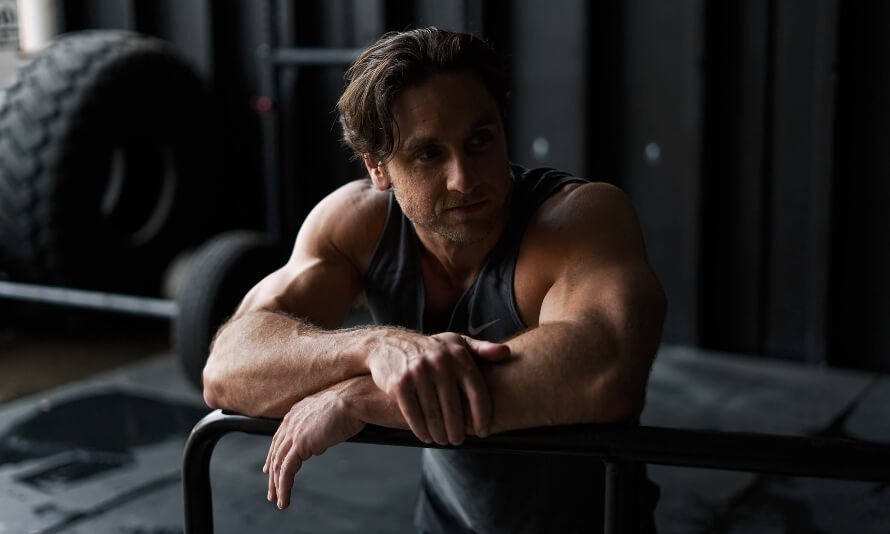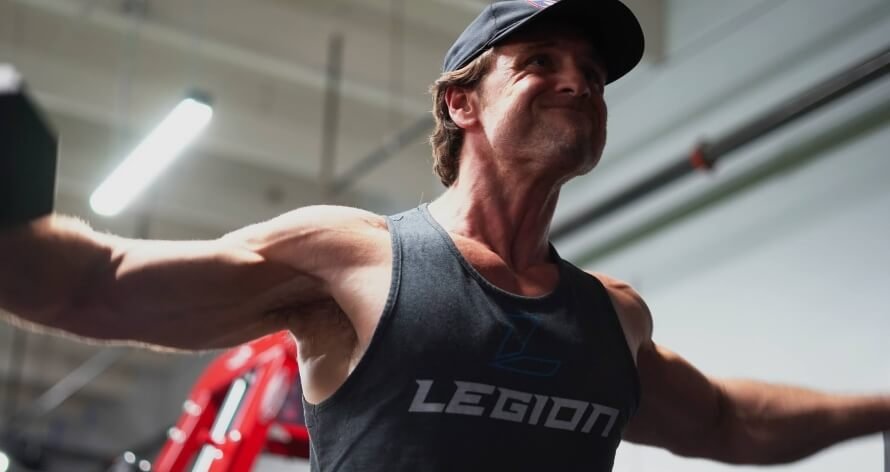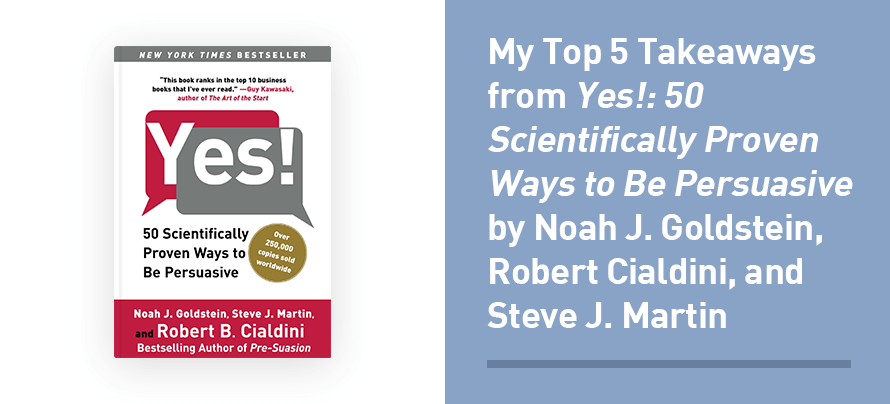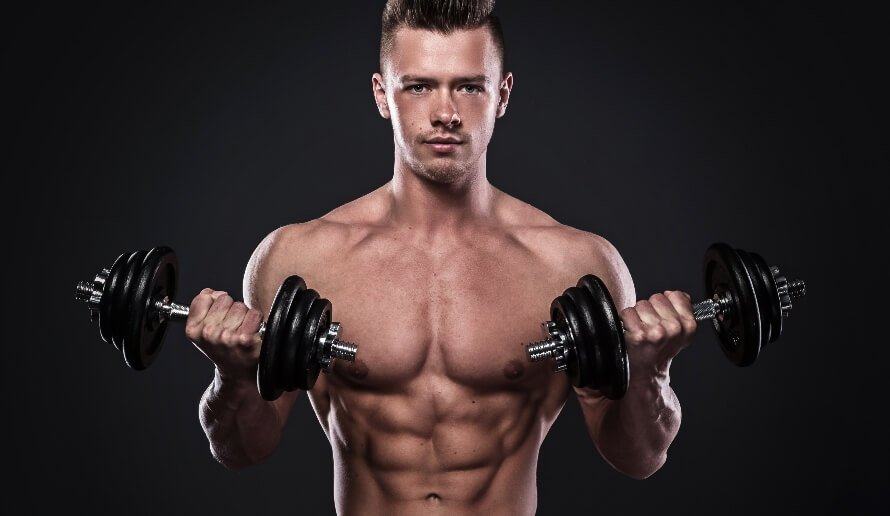[ad_1]
Evidence Based
The incline dumbbell curl is the go-to biceps builder for many savvy weightlifters.
That’s because it places tension on your biceps throughout the entire range of motion and allows you to train your biceps in a fully stretched position, both of which are highly beneficial for muscle growth.
In this article, you’ll learn what the dumbbell incline curl is, its benefits, which muscles it works, how to perform the exercise with proper form, the best incline dumbbell biceps curl alternatives, and more.
What Is the Incline Dumbbell Curl?
The seated incline dumbbell curl is a biceps isolation exercise. It involves sitting back on an incline bench while holding a dumbbell in each hand, lifting the dumbbells to your shoulders by bending at the elbows, then straightening your arms.
Some prefer a variation referred to as the “alternating dumbbell curl,” which involves alternating between your arms with every rep. Performing the exercise like this helps you to focus your attention on one biceps at a time, which may aid muscle growth in some scenarios.
The downside of the incline alternating dumbbell curl, however, is that it significantly extends the length of your sets, which isn’t ideal if you’re short on time.
That’s why most prefer to perform the incline dumbbell curl bilaterally (curling both arms simultaneously). As such, that’s the variation we’ll focus on in this article.
What’s the Best Incline Dumbbell Curl Angle?
As a general rule, an incline of 60 degrees works best.
Sitting more upright than this places your upper arms too close to your sides, negating the benefits of the exercise. Likewise, performing the exercise through a full range of motion at a lower angle requires a degree of shoulder mobility that most people lack, which may make it uncomfortable or force you to compromise form.
Still, everyone’s proportions, mobility, and preferences are different, so it’s best to experiment with various bench angles between 45 and 70 degrees to find what works best for you.
Incline Dumbbell Curl: Benefits
Research shows that using a variety of biceps exercises that place your upper arms in different positions relative to your torso is important for building proportional biceps.
The incline dumbbell curl is distinctive because it’s one of the few exercises that train your biceps when your arms are behind your body.
This makes it a valuable addition to your biceps workouts alongside exercises that position your arms by your sides, including the dumbbell and barbell curl, or forward of your torso, such as the preacher curl and chin-up.
Furthermore, placing your upper arms behind your torso fully stretches your biceps. This is noteworthy because research shows that training a muscle while it’s stretched is superior for muscle growth than training it while it’s relaxed.
Another benefit is that the incline curl places tension on the biceps throughout the entire range of motion. This may mean it’s slightly more effective for developing your biceps than other biceps exercises (the preacher curl, for example) that put little stress on the biceps at the top of each rep.
Incline Dumbbell Curl: Muscles Worked
The main muscles worked by the incline dumbbell curl are the biceps brachii (or “biceps”), the two-headed muscles on the front of your upper arms, between your shoulders and elbows.
Here’s how the biceps look on your body:
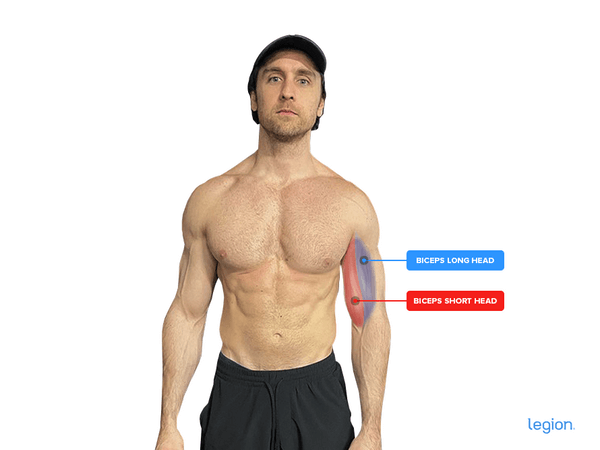
Incline Dumbbell Curl: Form
The best way to learn how to perform the dumbbell curl on an incline bench is to split the exercise into three parts: set up, curl, descend.
1. Set Up
Adjust a bench to around 60 degrees. Grab a dumbbell in each hand, sit on the bench with your feet planted on the floor, then lean back so that your back is against the backrest, your arms hang straight down, and your palms face forward.
2. Curl
Bend at the elbows to curl the dumbbells up until they’re in front of your shoulders.
Press your back against the backrest as you lift the dumbbells. This stops you from using momentum to “cheat” the weight up and ensures your biceps do the lion’s share of the work.
3. Descend
Lower the dumbbells and return to the starting position. Don’t let the weights fall back to the starting position or try to straighten your arms slowly. The entire “descent” should be controlled but only take about a second.
Here’s an incline dumbbell curl gif showing what it should look like when you put it all together:
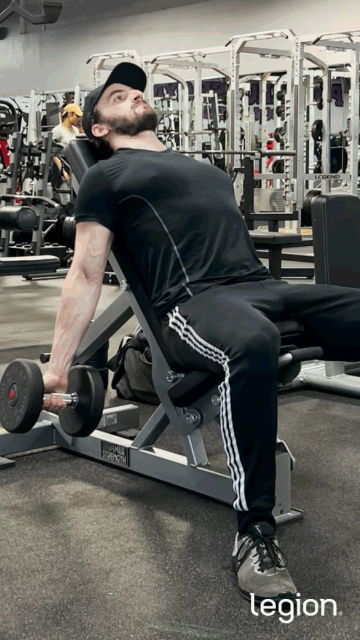
The Best Incline Dumbbell Curl Alternatives
1. Prone Dumbbell Incline Curl
https://www.youtube.com/watch?v=ke2shAeQ0O8
In the dumbbell prone incline curl, you perform a dumbbell curl with your chest against an incline bench, instead of your back. This keeps your arms in front of your body, which trains your biceps slightly differently than the incline dumbbell curl.
2. Incline Dumbbell Hammer Curl
https://www.youtube.com/watch?v=eaKl9YOCB_c
The incline dumbbell hammer curl is similar to the regular incline dumbbell curl, only your palms face each other, not forward. This wrist orientation emphasizes the brachialis, a small muscle beneath the biceps that significantly adds to the biceps’ size and circumference.
3. Bayesian Curl
https://www.youtube.com/watch?v=NEPp1Fh96X0
The main difference between the Bayesian cable curl and incline dumbbell curl is execution: in the Bayesian curl, you train each arm independently using a cable machine and while standing, whereas in the incline curl, you train both arms simultaneously using dumbbells and while seated.
However, both exercises work your biceps similarly and comparably, so you can use them interchangeably.
+ Scientific References
- Marchant DC, Greig M, Scott C. Attentional Focusing Instructions Influence Force Production and Muscular Activity During Isokinetic Elbow Flexions. Journal of Strength and Conditioning Research. 2009;23(8):2358-2366. doi:https://doi.org/10.1519/jsc.0b013e3181b8d1e5
- Lohse KR, Sherwood DE, Healy AF. Neuromuscular Effects of Shifting the Focus of Attention in a Simple Force Production Task. Journal of Motor Behavior. 2011;43(2):173-184. doi:https://doi.org/10.1080/00222895.2011.555436
- Marchant DC, Greig M. Attentional focusing instructions influence quadriceps activity characteristics but not force production during isokinetic knee extensions. Human Movement Science. 2017;52:67-73. doi:https://doi.org/10.1016/j.humov.2017.01.007
- Barakat C, Barroso R, Alvarez M, et al. The Effects of Varying Glenohumeral Joint Angle on Acute Volume Load, Muscle Activation, Swelling, and Echo-Intensity on the Biceps Brachii in Resistance-Trained Individuals. Sports. 2019;7(9):204. doi:https://doi.org/10.3390/sports7090204
- Oliveira LF, Matta TT, Alves DS, Garcia MAC, Vieira TMM. Effect of the shoulder position on the biceps brachii emg in different dumbbell curls. Journal of Sports Science & Medicine. 2009;8(1):24-29. https://www.ncbi.nlm.nih.gov/pmc/articles/PMC3737788/
- Oranchuk DJ, Storey AG, Nelson AR, Cronin JB. Isometric training and long-term adaptations: Effects of muscle length, intensity, and intent: A systematic review. Scandinavian Journal of Medicine & Science in Sports. 2019;29(4):484-503. doi:https://doi.org/10.1111/sms.13375
- Maeo S, Wu Y, Huang M, et al. Triceps brachii hypertrophy is substantially greater after elbow extension training performed in the overhead versus neutral arm position. European Journal of Sport Science. Published online July 12, 2022:1-26. doi:https://doi.org/10.1080/17461391.2022.2100279
- Pedrosa GF, Simões MG, Figueiredo MOC, et al. Training in the Initial Range of Motion Promotes Greater Muscle Adaptations Than at Final in the Arm Curl. Sports. 2023;11(2):39. doi:https://doi.org/10.3390/sports11020039
- Sato S, Yoshida R, Kiyono R, et al. Elbow Joint Angles in Elbow Flexor Unilateral Resistance Exercise Training Determine Its Effects on Muscle Strength and Thickness of Trained and Non-trained Arms. Frontiers in Physiology. 2021;12. doi:https://doi.org/10.3389/fphys.2021.734509
You May Also Like
Our Most Popular Evidence-Based Articles
You don’t need supplements to build muscle, lose fat, and get healthy. But the right ones can help.
Take our 60-second quiz now to learn which supplements can help you achieve your fitness goals faster.
Sending…
Your free stuff is on the way!
Follow the Diet Plan that Helped Nikita Lose 15 Pounds in 3 Months
“I never thought getting in shape would be this simple! Everything just WORKS when you follow this plan.” And if he can do it, why not you?

Wait!
Want a Free Custom Meal Planning Tool?
Quickly calculate your calories, macros, and micros for losing fat, building muscle, and staying healthy.
Our “No Return Necessary”
Money-Back Guarantee
If you don’t like something of ours, guess what happens next?
No, we don’t request you deliver it to a PO box in the Gobi Desert by carrier pigeon. Nor do we ask you to fill a cursed inkwell with orc’s blood and demon saliva and then use it to complete reams of return forms written in ancient Cyrillic script.
We just . . . wait for it . . . give you your money back. Holy moo cows. And that means you can say “yes” now and decide later.
Free Worldwide Shipping & Returns
Many companies use shipping and handling fees to increase their profit margins, but here at Legion, we hate profits, so our shipping is free!
Okay, so we do dig on profits, but we also go in for happy customers, and free shipping works like gangbusters. So, if you live in the United States, your order ships free regardless of order size, if you live in the UK or Canada, your order ships free when it’s over $99, and if you live elsewhere, your order ships free when it’s over $199.
Also, if you don’t absolutely love our stuff for whatever reason, we don’t request you deliver it to a PO box in the Gobi Desert by carrier pigeon.
We just . . . wait for it . . . give you your money back. No returns. No forms. No nonsense. Holy moo cows.
That means you can say “yes” now and decide later. You really have nothing to lose.
Free Worldwide Shipping & Returns
Many companies use shipping and handling fees to increase their profit margins, but here at Legion, we hate profits, so our shipping is free!
Okay, so we do dig on profits, but we also go in for happy customers, and free shipping works like gangbusters. So, if you live in the UK or Canada, your order ships free when it’s over $99.
Why the restriction on international orders? Unfortunately, shipping abroad is very expensive, and if we didn’t require a minimum order size, we’d lose a lot of money. But! We’re also hustling to improve our international logistics and will be passing our savings along to our international customers.
Also, if you don’t absolutely love our stuff for whatever reason, we don’t request you deliver it to a PO box in the Gobi Desert by carrier pigeon.
We just . . . wait for it . . . give you your money back. No returns. No forms. No nonsense. Holy moo cows.
That means you can say “yes” now and decide later. You really have nothing to lose.
Free Worldwide Shipping & Returns
Many companies use shipping and handling fees to increase their profit margins, but here at Legion, we hate profits, so our shipping is free!
Okay, so we do dig on profits, but we also go in for happy customers, and free shipping works like gangbusters. So, if you’re outside the USA, your order ships free when it’s over $199.
Why the restriction on international orders? Unfortunately, shipping abroad is very expensive, and if we didn’t require a minimum order size, we’d lose a lot of money. But! We’re also hustling to improve our international logistics and will be passing our savings along to our international customers.
Also, if you don’t absolutely love our stuff for whatever reason, we don’t request you deliver it to a PO box in the Gobi Desert by carrier pigeon.
We just . . . wait for it . . . give you your money back. No returns. No forms. No nonsense. Holy moo cows.
That means you can say “yes” now and decide later. You really have nothing to lose.
Clinically Effective Ingredients & Doses
Many ingredients in supplements don’t have any scientifically validated benefits, and many ingredients that do are often underdosed to the point of irrelevance.
That’s why we only use the choice ingredients and precise doses shown to be effective in peer-reviewed scientific studies.
Clinically Effective Doses
You need more than great ingredients to make great products—you also need proper doses. That’s why we use the precise doses of ingredients shown to be effective in peer-reviewed scientific studies.
100% Natural Ingredients
“Natural” doesn’t always mean “better,” but in many cases, natural ingredients are superior to artificial ones for various reasons, including purity, safety, and efficacy.
That’s why all of our ingredients in all of our products come from plant and animal sources, including sweeteners, colors, and flavors.
Made in USA
If you want to ensure the supplements you’re swallowing every day are safe and effective, you want products produced in the USA.
That’s why all of our supplements are made in America in NSF-certified and FDA-inspected facilities that operate in accordance with the Current Good Manufacturing Practice (cGMP) regulations.
Lab Tested
Did you know that supplements can contain dangerously high levels of toxins like lead, arsenic, and cadmium?
That’s why we test every ingredient of every supplement we produce for heavy metals, microbes, allergens, and other contaminants and ensure they meet the strict purity standards set by the FDA.
Naturally Sweetened & Flavored
While artificial sweeteners may not be as dangerous as some people claim, studies suggest that regular consumption of these chemicals may indeed be harmful to our health.
That’s why all of our supplements are naturally sweetened and flavored and contain no artificial food dyes, fillers, or other unnecessary junk.
Science-Backed Ingredients
Many ingredients in supplements don’t have any scientifically validated benefits. That’s why we only use choice ingredients shown to be effective in peer-reviewed scientific studies.
No Chemical Junk
“Natural” doesn’t always mean “better,” but in many cases, natural ingredients are superior to artificial ones for various reasons, including purity, safety, and efficacy.
That’s why all of our ingredients in all of our products come from plant and animal sources, including sweeteners, colors, and flavors.


Split your entire online purchase into 4 interest-free payments, over 6 weeks with no impact to your credit.

25%
today
25%
2 weeks
25%
4 weeks
25%
6 weeks

Shop and add items to your cart as normal!

Choose Sezzle at Checkout! You’ll be redirected to Sezzle to Sign Up or Log In
to complete your order.

Your order will be shipped out right away* and your payments will be split up
over 6 weeks.
*shipping times subject to merchant shipping policy
Shop directory. Reschedule payments. Plus more!
Waiver and Release of Liability
In consideration of the services and/or products offered by Legion Athletics, Inc. (“Legion”) including, but not limited to, nutrition plans, exercise routines and coaching, and in addition to the payment of any fee or charge:
I knowingly and voluntarily enter into this waiver and release of liability and hereby waive any and all rights, claims or causes of action of any kind whatsoever arising out of my use of Legion’s services and/or products, and I hereby release and hold harmless Legion and its consultants, officers, contractors, agents, owners and employees from any and all responsibility, liability, cost and expenses, including for injuries, damages or disorders (physical, metabolic, or otherwise), resulting from my use of Legion’s services and/or products.
I understand that fitness activities including, but not limited to, strength, flexibility, and cardiovascular exercise, with or without the use of equipment, are potentially hazardous activities that involve a risk of injury and even death, and I am voluntarily participating in these activities and using equipment and machinery with knowledge of the risks involved. I hereby agree to assume and accept any and all risks of injury or death related to said fitness activities.
I understand Legion’s services and products are not meant to treat or manage any health conditions or circumstances, and I acknowledge that Legion has recommended I obtain a healthcare provider’s approval for my use of Legion’s services and/or products, through regular physical examination(s) and/or consultation. I acknowledge that I have obtained my healthcare provider’s approval or have decided to use Legion’s services and/or products without such approval and hereby assume all responsibility for my use of said services and/or products.
I understand that results from using Legion’s products and/or services are not guaranteed, and I agree to not hold Legion liable for any outcomes or lack thereof.
OUT OF STOCK
Security Check
Please click the checkbox below. We apologize for the inconvenience.
If you don’t absolutely love this product, just let us know, and we’ll give you a full refund on the spot. No forms or return necessary.
Analyzed for purity and potency in a state-of-the-art ISO 17025 accredited lab by Labdoor™, the gold standard of third-party lab testing.
Analyzed for purity and potency in a state-of-the-art ISO 17025 accredited lab, the gold standard of third-party lab testing.
This product doesn’t just “contain natural ingredients’’—every ingredient is naturally sourced from plants and animals. This product contains no artificial or synthetic substances of any kind.
Fact Checked
Our scientific review board of nutritionists, dietitians, molecular biologists, doctors, and other accredited experts is responsible for reviewing every article, podcast, and video we produce to ensure they’re evidence based, accurate, trustworthy, and current.
Thanks to their connections, credentials, and academic experience, this team of MDs, PhDs, and other professionals has access to a wealth of research published in the largest and most prestigious journals in the world.
This allows them to not only review individual studies but also analyze the overall weight of the evidence on any and all topics related to diet, exercise, supplementation, and more.
If you feel that any of our content is inaccurate, misleading, out-of-date, or anything less than factual, please let us know in the comments section of the article in question.
Evidence Based
We follow a detailed, rigorous, multi-step process to create content that meets the highest standards of clarity, practicality, and scientific integrity.
First, our research associates provide our editorial team with accurate, up-to-date, proven scientific evidence.
Then, our editorial team uses this research to draft articles and outlines for podcasts and videos.
Finally, our scientific review board reviews the content to ensure all key information and claims are backed by high-quality scientific research and explained simply and precisely.
If you feel that any of our content is inaccurate, misleading, out-of-date, or anything less than factual, please let us know in the comments section of the article in question.
[ad_2]
Source link
